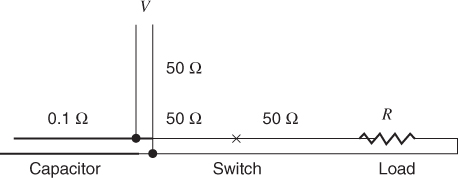4.3 Capacitors
The classic capacitor consists of parallel conducting planes separated by a dielectric. The symbol for a capacitor implies that connections are made to a mid point on the planes. Many practical capacitors are made by stacking several conducting planes and making appropriate connections to the conductors. To be effective, a capacitor should supply current on demand with a limited sag in voltage. For a step function load, this requires a low characteristic impedance at the capacitor terminals.
To simplify the discussion, consider a two-terminal capacitor as shown in Figure 4.2.
Figure 4.2 A capacitor as a transmission line in a circuit. The values shown are characteristic impedances.

For a two-terminal capacitor, energy must enter and leave through the same port. When a load is applied to this geometry, energy is supplied to the load from the capacitor and from any connecting transmission lines (traces). This includes logic lines connected in the IC. The majority of the energy eventually comes from the capacitor. After the load is connected, waves travel into the capacitor and onto any other connecting transmission lines. The wave that travels into the capacitor, reflects at the open end and brings back energy to the load.2 The ...
Get Digital Circuit Boards: Mach 1 GHz now with the O’Reilly learning platform.
O’Reilly members experience books, live events, courses curated by job role, and more from O’Reilly and nearly 200 top publishers.

